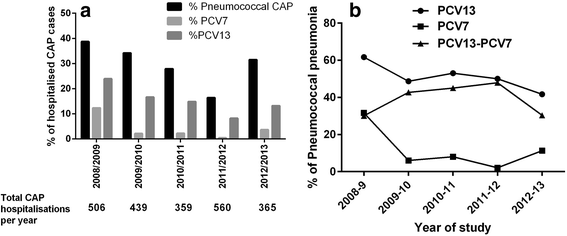A systematic review of the burden of vaccine preventable pneumococcal disease in UK adults
- PMID: 27169895
- PMCID: PMC4864929
- DOI: 10.1186/s12890-016-0242-0
A systematic review of the burden of vaccine preventable pneumococcal disease in UK adults
Abstract
Background: Invasive pneumococcal disease (IPD) and pneumococcal pneumonia are common and carry a significant morbidity and mortality. Current strategies to prevent pneumococcal disease are under review in the United Kingdom (UK). We conducted a systematic review to evaluate the burden of vaccine type adult pneumococcal disease specifically in the UK.
Methods: A systematic review conducted and reported according to MOOSE guidelines. Relevant studies from 1990 to 2015 were included. The primary outcome was the incidence of vaccine type pneumococcal disease, focussing on the pneumococcal polysaccharide vaccine (PPSV), the 13-valent conjugate vaccine (PCV13) and the 7-valent conjugate vaccine (PCV7).
Results: Data from surveillance in England and Wales from 2013/14 shows an incidence of 6.85 per 100,000 population across all adult age groups for IPD, and an incidence of 20.58 per 100,000 population in those aged >65 years. The corresponding incidences for PCV13 serotype IPD were 1.4 per 100,000 and 3.72 per 100,000. The most recent available data for community-acquired pneumonia (CAP) including non-invasive disease showed an incidence of 20.6 per 100,000 for adult pneumococcal CAP and 8.6 per 100,000 population for PCV13 serotype CAP. Both IPD and CAP data sources in the UK suggest an ongoing herd protection effect from childhood PCV13 vaccination causing a reduction in the proportion of cases caused by PCV13 serotypes in adults. Despite this, applying the incidence rates to UK population estimates suggests more than 4000 patients annually will be hospitalised with PCV13 serotype CAP and more than 900 will be affected by IPD, although with a trend for these numbers to decrease over time. There was limited recent data on serotype distribution in high risk groups such as those with chronic respiratory or cardiac disease and no data available for vaccine type (VT) CAP managed in the community where there is likely to be a considerable unmeasured burden.
Conclusion: The most recent available data suggests that VT pneumococcal disease continues to have a high burden in UK adults despite the impact of childhood PCV13 vaccination. IPD estimates represent only a fraction of the total burden of pneumococcal disease.
Study registration: PROSPERO CRD42015025043.
Keywords: Epidemiology; Infection; Mortality; Pneumonia; Vaccine.
Figures




References
Publication types
MeSH terms
Substances
LinkOut - more resources
Full Text Sources
Other Literature Sources
Miscellaneous

